Unit 5 What are the shirts made of? 单元教学案(4课时)
文档属性
| 名称 | Unit 5 What are the shirts made of? 单元教学案(4课时) | 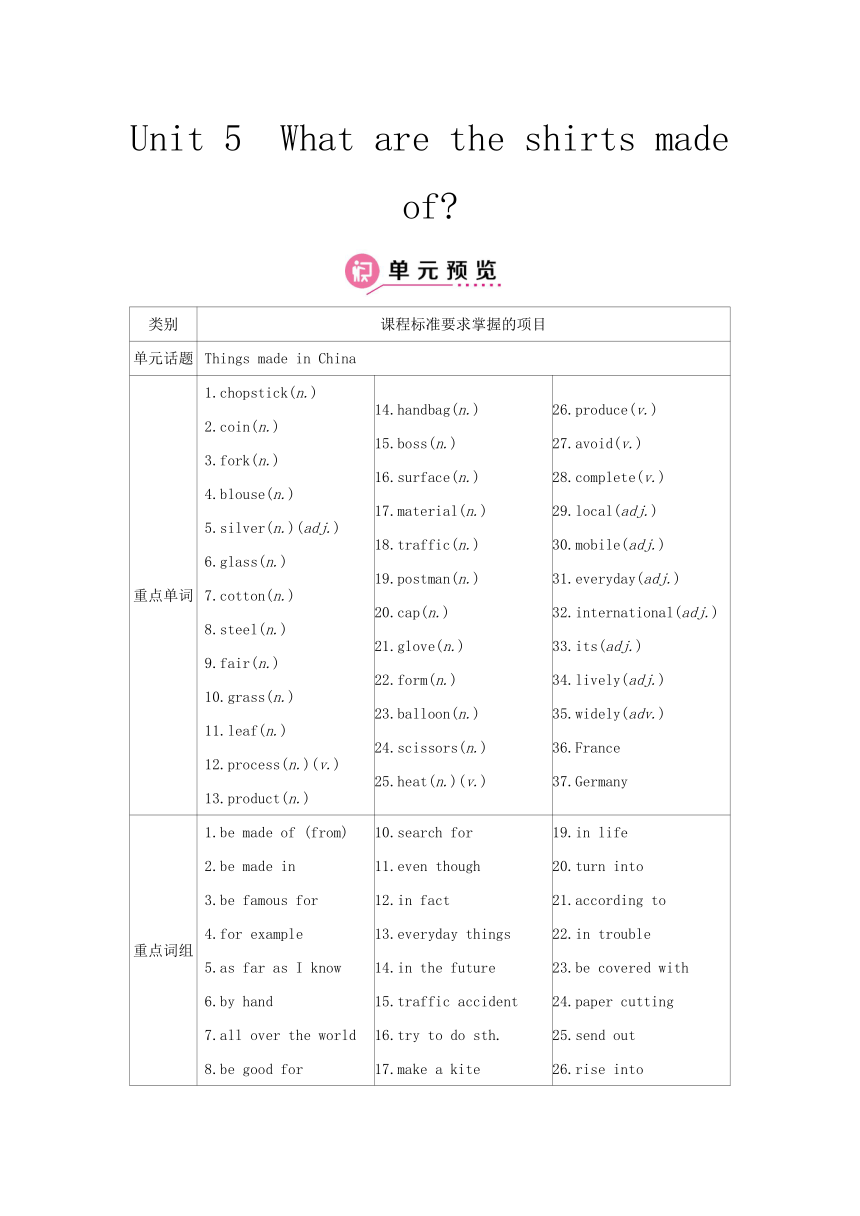 | |
| 格式 | docx | ||
| 文件大小 | 82.4KB | ||
| 资源类型 | 教案 | ||
| 版本资源 | 人教新目标(Go for it)版 | ||
| 科目 | 英语 | ||
| 更新时间 | 2021-09-11 14:00:04 | ||
图片预览

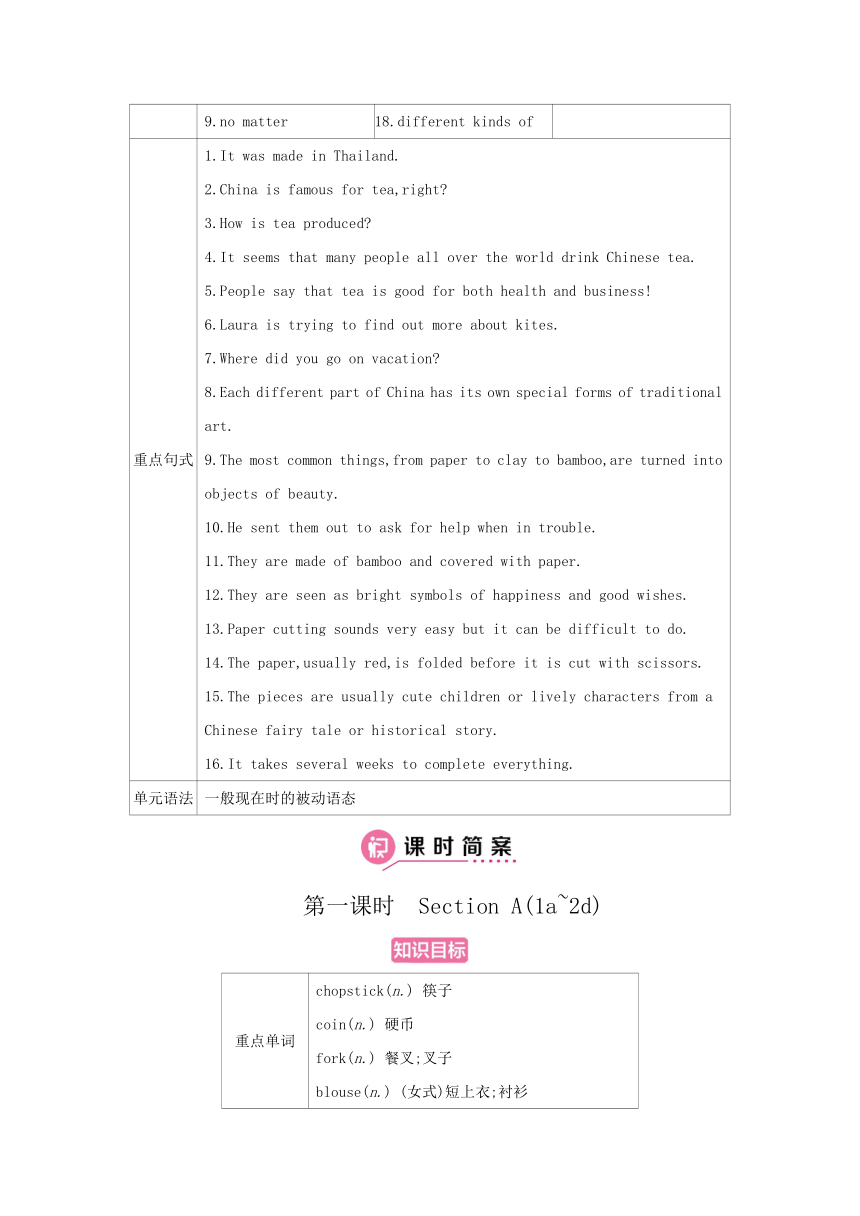
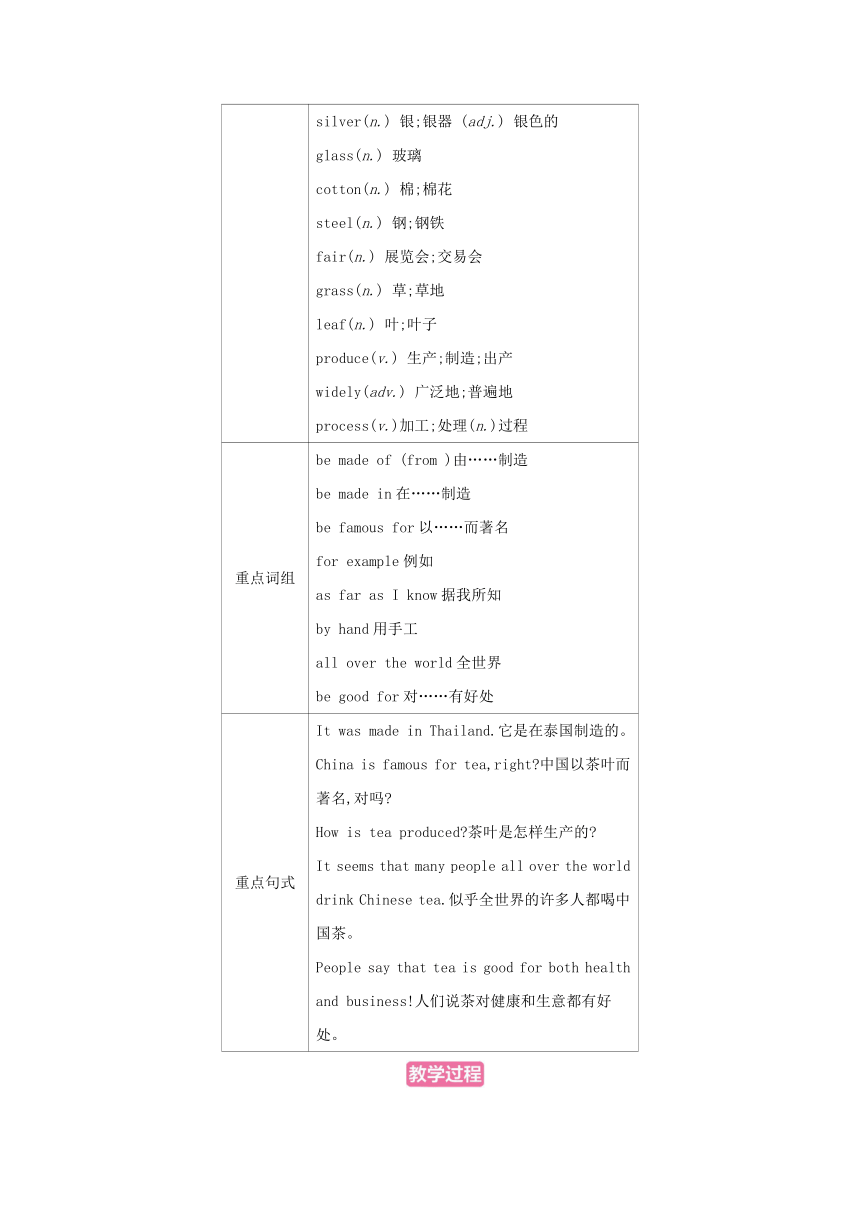
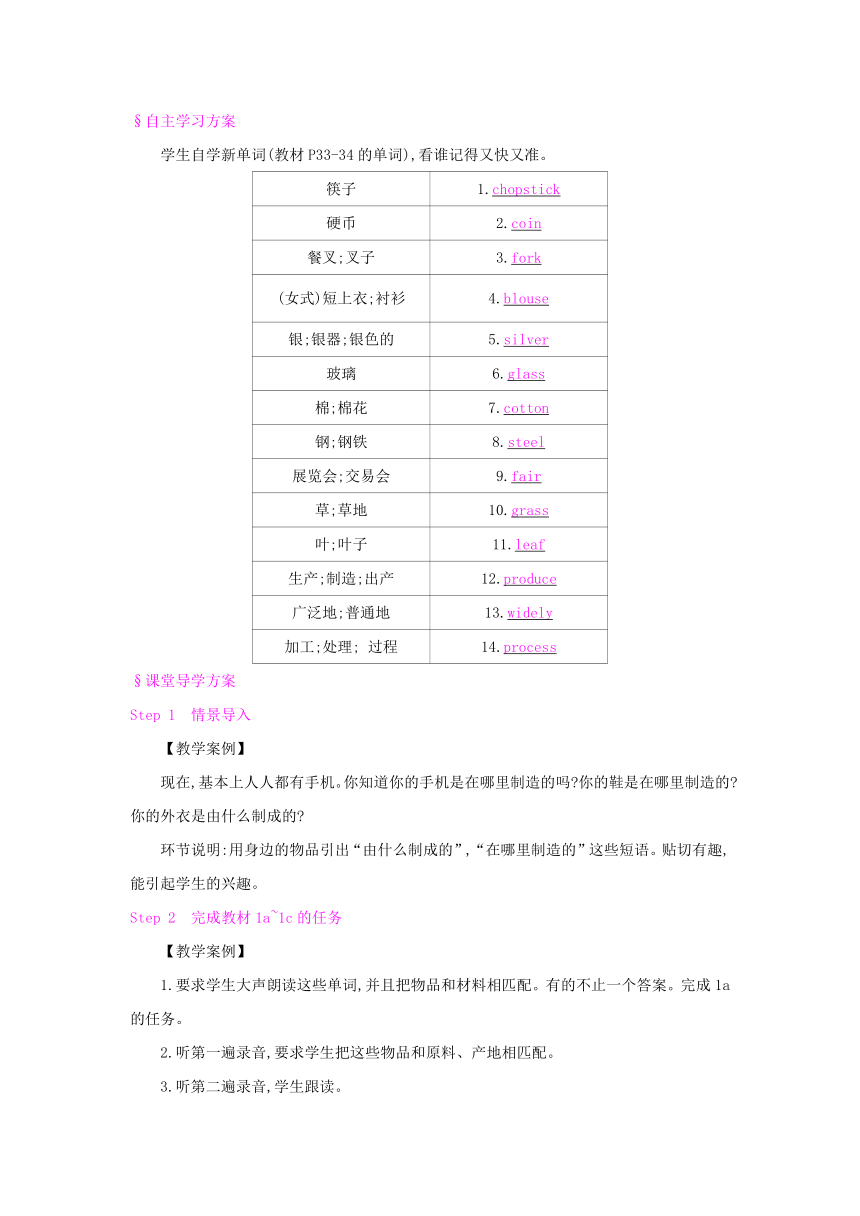
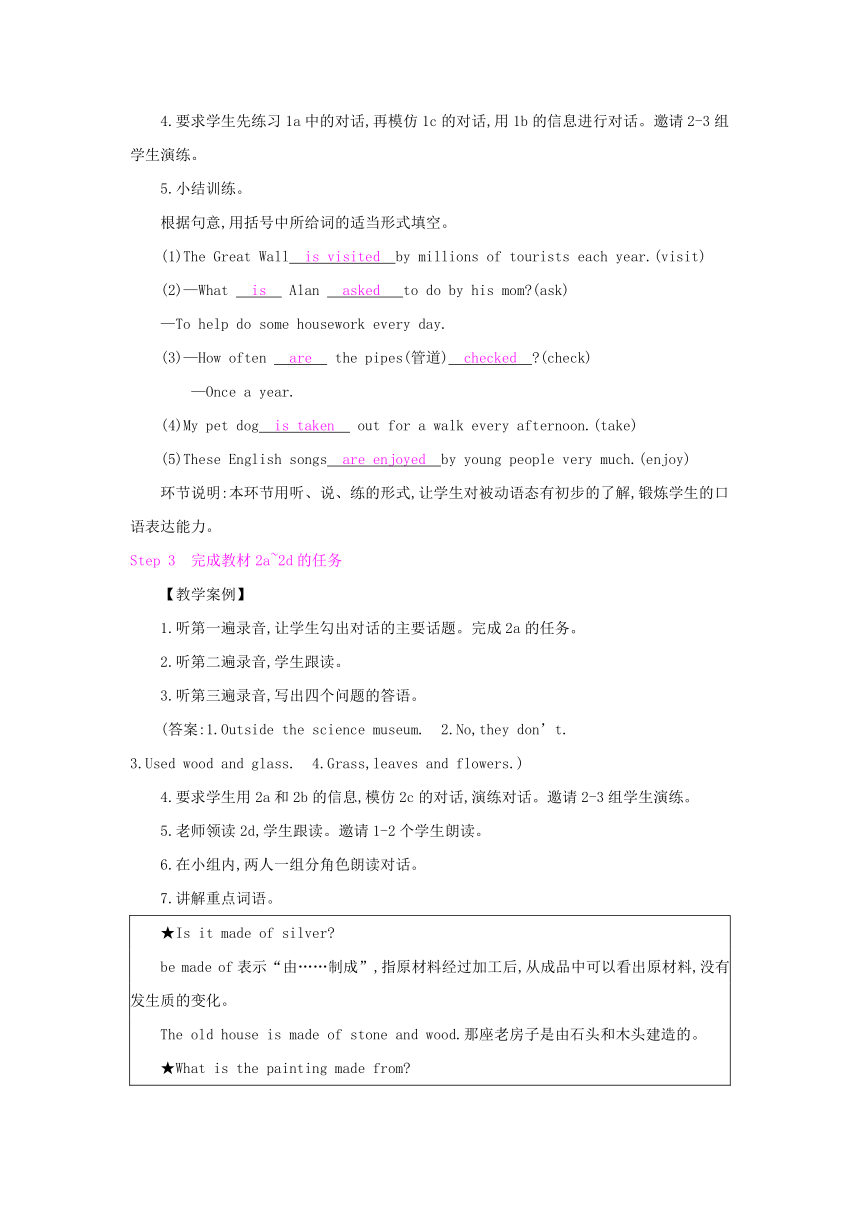
文档简介
Unit
5
What
are
the
shirts
made
of?
类别
课程标准要求掌握的项目
单元话题
Things
made
in
China
重点单词
1.chopstick(n.)
2.coin(n.)
3.fork(n.)
4.blouse(n.)
5.silver(n.)(adj.)
6.glass(n.)
7.cotton(n.)
8.steel(n.)
9.fair(n.)
10.grass(n.)
11.leaf(n.)
12.process(n.)(v.)
13.product(n.)
14.handbag(n.)
15.boss(n.)
16.surface(n.)
17.material(n.)
18.traffic(n.)
19.postman(n.)
20.cap(n.)
21.glove(n.)
22.form(n.)
23.balloon(n.)
24.scissors(n.)
25.heat(n.)(v.)
26.produce(v.)
27.avoid(v.)
plete(v.)
29.local(adj.)
30.mobile(adj.)
31.everyday(adj.)
32.international(adj.)
33.its(adj.)
34.lively(adj.)
35.widely(adv.)
36.France
37.Germany
重点词组
1.be
made
of
(from)
2.be
made
in
3.be
famous
for
4.for
example
5.as
far
as
I
know
6.by
hand
7.all
over
the
world
8.be
good
for
9.no
matter
10.search
for
11.even
though
12.in
fact
13.everyday
things
14.in
the
future
15.traffic
accident
16.try
to
do
sth.
17.make
a
kite
18.different
kinds
of
19.in
life
20.turn
into
21.according
to
22.in
trouble
23.be
covered
with
24.paper
cutting
25.send
out
26.rise
into
重点句式
1.It
was
made
in
Thailand.
2.China
is
famous
for
tea,right?
3.How
is
tea
produced?
4.It
seems
that
many
people
all
over
the
world
drink
Chinese
tea.
5.People
say
that
tea
is
good
for
both
health
and
business!
6.Laura
is
trying
to
find
out
more
about
kites.
7.Where
did
you
go
on
vacation?
8.Each
different
part
of
China
has
its
own
special
forms
of
traditional
art.
9.The
most
common
things,from
paper
to
clay
to
bamboo,are
turned
into
objects
of
beauty.
10.He
sent
them
out
to
ask
for
help
when
in
trouble.
11.They
are
made
of
bamboo
and
covered
with
paper.
12.They
are
seen
as
bright
symbols
of
happiness
and
good
wishes.
13.Paper
cutting
sounds
very
easy
but
it
can
be
difficult
to
do.
14.The
paper,usually
red,is
folded
before
it
is
cut
with
scissors.
15.The
pieces
are
usually
cute
children
or
lively
characters
from
a
Chinese
fairy
tale
or
historical
story.
16.It
takes
several
weeks
to
complete
everything.
单元语法
一般现在时的被动语态
第一课时 Section
A(1a~2d)
重点单词
chopstick(n.)
筷子
coin(n.)
硬币
fork(n.)
餐叉;叉子
blouse(n.)
(女式)短上衣;衬衫
silver(n.)
银;银器
(adj.)
银色的
glass(n.)
玻璃
cotton(n.)
棉;棉花
steel(n.)
钢;钢铁
fair(n.)
展览会;交易会
grass(n.)
草;草地
leaf(n.)
叶;叶子
produce(v.)
生产;制造;出产
widely(adv.)
广泛地;普遍地
process(v.)加工;处理(n.)过程
重点词组
be
made
of
(from
)由……制造
be
made
in在……制造
be
famous
for以……而著名
for
example例如
as
far
as
I
know据我所知
by
hand用手工
all
over
the
world全世界
be
good
for对……有好处
重点句式
It
was
made
in
Thailand.它是在泰国制造的。
China
is
famous
for
tea,right?中国以茶叶而著名,对吗?
How
is
tea
produced?茶叶是怎样生产的?
It
seems
that
many
people
all
over
the
world
drink
Chinese
tea.似乎全世界的许多人都喝中国茶。
People
say
that
tea
is
good
for
both
health
and
business!人们说茶对健康和生意都有好处。
§自主学习方案
学生自学新单词(教材P33-34的单词),看谁记得又快又准。
筷子
1.chopstick
硬币
2.coin
餐叉;叉子
3.fork
(女式)短上衣;衬衫
4.blouse
银;银器;银色的
5.silver
玻璃
6.glass
棉;棉花
7.cotton
钢;钢铁
8.steel
展览会;交易会
9.fair
草;草地
10.grass
叶;叶子
11.leaf
生产;制造;出产
12.produce
广泛地;普通地
13.widely
加工;处理;
过程
14.process
§课堂导学方案
Step
1 情景导入
【教学案例】
现在,基本上人人都有手机。你知道你的手机是在哪里制造的吗?你的鞋是在哪里制造的?你的外衣是由什么制成的?
环节说明:用身边的物品引出“由什么制成的”,“在哪里制造的”这些短语。贴切有趣,能引起学生的兴趣。
Step
2 完成教材1a~1c的任务
【教学案例】
1.要求学生大声朗读这些单词,并且把物品和材料相匹配。有的不止一个答案。完成1a的任务。
2.听第一遍录音,要求学生把这些物品和原料、产地相匹配。
3.听第二遍录音,学生跟读。
4.要求学生先练习1a中的对话,再模仿1c的对话,用1b的信息进行对话。邀请2-3组学生演练。
5.小结训练。
根据句意,用括号中所给词的适当形式填空。
(1)The
Great
Wall is
visited by
millions
of
tourists
each
year.(visit)
?
(2)—What
is
Alan
asked
to
do
by
his
mom?(ask)
?
—To
help
do
some
housework
every
day.
(3)—How
often
are
the
pipes(管道) checked ?(check)?
—Once
a
year.
(4)My
pet
dog is
taken
out
for
a
walk
every
afternoon.(take)?
(5)These
English
songs are
enjoyed by
young
people
very
much.(enjoy)
?
环节说明:本环节用听、说、练的形式,让学生对被动语态有初步的了解,锻炼学生的口语表达能力。
Step
3 完成教材2a~2d的任务
【教学案例】
1.听第一遍录音,让学生勾出对话的主要话题。完成2a的任务。
2.听第二遍录音,学生跟读。
3.听第三遍录音,写出四个问题的答语。
(答案:1.Outside
the
science
museum. 2.No,they
don’t.
3.Used
wood
and
glass. 4.Grass,leaves
and
flowers.)
4.要求学生用2a和2b的信息,模仿2c的对话,演练对话。邀请2-3组学生演练。
5.老师领读2d,学生跟读。邀请1-2个学生朗读。
6.在小组内,两人一组分角色朗读对话。
7.讲解重点词语。
★Is
it
made
of
silver?
be
made
of表示“由……制成”,指原材料经过加工后,从成品中可以看出原材料,没有发生质的变化。
The
old
house
is
made
of
stone
and
wood.那座老房子是由石头和木头建造的。
★What
is
the
painting
made
from?
be
made
from表示“由……制成”,指原材料经过加工后,从成品中看不出原材料,发生了质的变化。
Paper
is
made
from
wood.纸是由木头制成的。
★Yes,and
it
was
made
in
Thailand.
be
made
in表示“在……制造的”,
in后常接表示地点
的名词。
The
computer
is
made
in
America.这台电脑是美国生产的。
8.小结训练。
将下列句子中汉语部分译成英语,注意使用适当的形式。
(1)Do
you
think
this
ring is
made
of
silver ?(由银制成的)?
(2)My
hometown is
famous
for
its
lots
of
grass.(因……而闻名)?
(3) It
seems
that
those
grapes
are
made
of
glass.(看起来像)?
(4) As
far
as
I
know ,this
kind
of
plants
are
on
the
sides
of
rivers.(据我所知)?
(5)This
town
is
famous
for
making
clothes by
hand
.(手工)?
环节说明:将听、说、读、写结合起来,能锻炼学生的语言综合运用能力,巩固了对目标语言的理解和运用。
第二课时 Section
A(3a~4c)
重点单词
product(n.)
产品;制品
France法国
local(adj.)
当地的;本地的
avoid(v.)
避免;回避
handbag(n.)
小手提包
mobile(adj.)
可移动的;非固定的
everyday(adj.)
每天的;日常的
boss(n.)
老板;上司
Germany德国
surface(n.)
表面;表层
material(n.)
材料;原料
traffic(n.)
交通;路上行驶的车辆
postman(n.)
邮递员
cap(n.)
(尤指有帽舌的)
帽子
glove(n.)
(分手指的)
手套
重点词组
no
matter不论;无论
search
for搜索
even
though即使
in
fact事实上
everyday
things日常用品
in
the
future在未来
traffic
accident
交通事故
重点句式
However,you
could
be
wrong.然而,你有可能错了。
Toys
are
not
the
only
things
made
in
China.玩具不是唯一在中国制造的物品。
重点句式
He
realized
that
Americans
can
hardly
avoid
buying
products
made
in
China.他意识到美国人几乎无法避免购买中国制造的产品。
Are
your
shirts
made
of
cotton?你的衬衫是由棉布制成的吗?
§自主学习方案
学生自学新单词(教材P35-36的单词),看谁记得又快又准。
产品;制品
1.product
法国
2.France
当地的;本地的
3.local
避免;回避
4.avoid
小手提包
5.handbag
可移动的;非固定的
6.mobile
每天的;日常的
7.everyday
老板;上司
8.boss
德国
9.Germany
表面;表层
10.surface
材料;原料
11.material
交通;路上行驶的车辆
12.traffic
邮递员
13.postman
(尤指有帽舌的)
帽子
14.cap
(分手指的)
手套
15.glove
§课堂导学方案
Step
1 情景导入
【教学案例】
中国是个制造大国,无论你走到世界各地哪个国家,都能看到中国制造的产品。“Made
in
China”已经响彻全球。今天我们就学习一个中国人在美国找到中国制造的产品的故事。
环节说明:本环节通过介绍中国是个制造大国,让学生有自豪感,从而引起学习的兴趣。
Step
2 完成3a~3c的任务
【教学案例】
1.要求学生带着两个问题默读课文,找出两个问题的答案。完成3a的任务。
(答案:1.A
toy
car
and
a
pair
of
basketball
shoes. 2.They
were
made
in
China.)
2.要求学生再次默读课文,回答这5个问题,完成3b的任务。
要求1-2个学生回答问题。然后老师订正答案。
3.讲解课文中的重点句式和词语。
★No
matter
what
you
may
buy,you
might
think
those
products
were
made
in
those
countries.
(1)no
matter意为“不论;无论”,引导让步状语从句,常与what,which,who,where,when,how
等连用,其引导的从句既可置于主句之前,也可置于主句之后。
No
matter
what
you
say,I
won’t
believe
you.无论你说什么,我都不会相信你。
(2)“no
matter
+疑问词”
结构相当于“疑问词+ever”。no
matter
how
=
however;no
matter
what
=whatever;no
matter
when
=
whenever;no
matter
where
=
wherever。
No
matter
where
you
go,you
should
remember
your
home.
=
Wherever
you
go,you
should
remember
your
home.无论你去哪儿,你都要记住你的家。
★He
found
it
interesting
that
so
many
products
in
the
local
shops
were
made
in
China.
“find
it
+形容词+that
从句”意为“发现……(是怎样的)”,其中it
做find的形式宾语,that引导的从句为真正的宾语。形容词做宾语补足语。
I
found
it
difficult
that
we
must
finish
the
work
in
three
days.我发现在三天内我们必须完成这项工作是困难的。
★He
realized
that
Americans
can
hardly
avoid
buying
products
made
in
China.
avoid为及物动词,意为“避免;回避”,其后可接名词、代词或动词-ing形式做宾语。
The
old
man
avoids
his
neighbors.那位老人回避他的邻居。
He
avoided
answering
my
questions.他避免回答我的问题。
★Kang
Jian
thinks
it’s
great
that
China
is
so
good
at
making
these
everyday
things.
everyday做形容词,意为“日常的”,一般在句中做定语。
I
learn
everyday
English.我学习日常英语。
【拓展】 every
day
是表示时间的短语,该短语一般在句中做时间状语。
Don’t
eat
too
much
every
day.每天不要吃太多。
4.再读一遍课文,写出3c中所给词所指代的内容。
环节说明:将读、讲、写结合起来,锻炼学生的语言综合运用能力,巩固学生对目标语言的运用。
Step
3 完成教材Grammar
Focus~4c的任务
【教学案例】
1.要求学生大声朗读Grammar
Focus的句子。老师再领读一遍。找1-2个学生将句子翻译成汉语。
2.要求学生总结出表格中被动语态的构成。
3.要求学生用括号里所给词语的正确形式填空。完成4a的任务。
(答案:1.aren’t
allowed
2.are
paid 3.is
spoken 4.is
covered
5.is
cleaned
)
4.要求学生大声朗读4b的句子,并改写成被动语态。邀请1-2个学生在黑板上写出被动语态的句子。
5.根据4c左侧方框中提供的单词,按照右侧方框所提供的对话,向5位同学询问他们的穿戴及书包中所包含的物品。然后再与同伴交流讨论。
6.小结训练。
用括号中所给词的适当形式填空。
(1)Two
eggs are
eaten
by
her
every
morning.(eat)?
(2)English is
spoken as
a
foreign
language
in
China.(speak)
?
(3)The
housework
is
done
by
me
on
weekends.(do)?
(4)Flowers are
watered
by
them
in
the
afternoon.
(water)?
(5)Music is
listened
to
by
us
after
class.(listen)
?
环节说明:本环节以自学为主,引导学生总结出一般现在时的被动语态的构成。
第三课时 Section
B(1a~1e)
重点单词
international
(adj.)
国际的
competitor
(n.)
参赛者;竞争者
重点词组
try
to
do
sth.尽力做某事
make
a
kite制作风筝
different
kinds
of
不同种类的
重点句式
Laura
is
trying
to
find
out
more
about
kites.劳拉正在试图了解更多的关于风筝的事情。
Where
did
you
go
on
vacation?你去哪里度假了?
§自主学习方案
学生自学新单词(教材P37的单词),看谁记得又快又准。
国际的
1.international
参赛者;竞争者
2.competitor
§课堂导学方案
Step
1 情景导入
【教学案例】
展示一些风筝的图片。古老的风筝传到现在一定有它的魅力。你知道风筝的故乡吗?
环节说明:通过展示图片,激发学生的学习兴趣和表达欲望。
Step
2 完成教材1a~1d的任务
【教学案例】
1.在展示图片的基础上,询问学生会不会放风筝,风筝是由什么制成的,让学生填写制作风筝所需要的原材料,完成1a的任务。
2.听第一遍录音,圈出正确的答案,完成1b的任务。邀请1-2个学生朗读书上的句子。
3.听第二遍录音,学生跟读。
4.听第三遍录音,给5个句子填上主语,完成1c的任务。邀请1-2个学生朗读书上的句子。
5.听第四遍录音,填入所听到的词语。完成1d的任务。
环节说明:本环节以听为主,培养了学生的听力技巧,巩固学生对目标语言的运用。
Step
3 完成教材1e的任务
【教学案例】
1.放下听力材料,要求学生模仿听力内容,利用1b、1d的信息分角色练习对话。邀请2-3组学生演练。
2.小结训练。
将下列句子中汉语部分译成英语,注意使用适当的形式。
(1)They went
on
vacation to
Weifang.(去度假)?
(2)The
woman
is
not
young,but
she
likes
wearing
colorful
clothes .(颜色鲜艳的衣服)?
(3)Most
of
the
kites
flying
high
in
the
sky are
made
of
paper
and
bamboo.(用……制成).?
(4)I
hope
our
city
can
hold
some
big
international
competitions
,such
as
the
Olympic
Games
and
the
World
Cup.(国际比赛)?
环节说明:本环节以说、练为主,让学生在练的过程中,掌握目标语言。
第四课时 Section
B(2a~Self
Check)
重点单词
its(adj.)
它的
form(n.)
形式;类型
balloon(n.)
气球
scissors(n.)
(pl.)
剪刀
lively(adj.)
生气勃勃的;(色彩)鲜艳的
heat(n.)
热;高温
(v.)
加热;变热
complete
(v.)
完成
重点词组
in
life在生活中
turn
into变成
according
to按照
in
trouble陷入困境
be
covered
with用……覆盖
paper
cutting剪纸
send
out发出
重点句式
Each
different
part
of
China
has
its
own
special
forms
of
traditional
art.中国的每个不同的地区都有自己特殊的传统艺术形式。
The
most
common
things,from
paper
to
clay
to
bamboo,are
turned
into
objects
of
beauty.最普
重点句式
通的东西,从纸到黏土到竹子,都被变成了具有美感的物品。
He
sent
them
out
to
ask
for
help
when
in
trouble.在遇到困难时,他放飞它们以寻求帮助。
They
are
made
of
bamboo
and
covered
with
paper.它们是由竹子制成,并用纸糊上的。
They
are
seen
as
bright
symbols
of
happiness
and
good
wishes.它们被看作是幸福和美好祝愿的明亮的象征。
Paper
cutting
sounds
very
easy
but
it
can
be
difficult
to
do.剪纸听起来很容易,但是做起来很难。
The
paper,usually
red,is
folded
before
it
is
cut
with
scissors.纸通常是红色的,用剪刀剪裁之前先折叠好。
The
pieces
are
usually
cute
children
or
lively
characters
from
a
Chinese
fairy
tale
or
historical
story.这些作品通常是可爱的孩子们或者是来自中国神话故事或者历史故事中的生动的人物。
It
takes
several
weeks
to
complete
everything.完成所有工艺需要花费几周的时间。
§自主学习方案
学生自学新单词(教材P38-40的单词),看谁记得又快又准。
它的
1.its
形式;类型
2.form
气球
3.balloon
剪刀
4.scissors
生气勃勃的;(色彩)鲜艳的
5.lively
热;高温;加热;变热
6.heat
完成
7.complete
§课堂导学方案
Step
1 情景导入
【教学案例】
展示一些孔明灯、剪纸、泥塑的图片,让学生对这些物品进行了解,老师可以设问。引导学生进行讨论。
Do
you
know
what
they
are
made
of?
环节说明:通过带着问题学习短文,从而达到导入新课的目的。
Step
2 完成教材2a~2e的任务
【教学案例】
1.要求学生带着上述图片的讨论结果,完成2a、2b
的任务。读完课文后,填写课文后的表格。
2.老师领读课文,学生跟读。让学生大声朗读一遍。
3.再次阅读课文,回答6个问题,完成2c的任务。邀请1—2个学生将答案写在黑板上。
4.用方框中所给短语的正确形式填空,完成2d的任务。邀请1-2个学生朗读这三个小题的句子。
5.要求学生在小组内讨论这些问题,完成2e的任务。邀请1-2组学生演练这些对话。
6.讲解重点词语。
★They
are
made
of
bamboo
and
covered
with
paper.
be
covered
with意为“被……覆盖”,其主动形式为cover
sth.with
sth.意为“用……覆盖……”。
We
hope
the
desert
would
be
covered
with
trees.我们希望沙漠都被树木覆盖。
★The
pieces
are
usually
cute
children
or
lively
characters
from
a
Chinese
fairy
tale
or
historical
story.
lively意为“生气勃勃的,(色彩)鲜艳的”,可在句中做
定语、表语或宾语补足语,既可指人,也可指物。
The
lecture
is
very
lively.这次演讲很生动。
【拓展】 (1)living意为“活着的”,强调说明“健在”,常做表语或定语,多用于指物,也可指人。
The
old
woman
is
still
living.那位老妇人仍活着。
(2)live意为“活的”,一般做定语,只修饰物,不修饰人。
Don’t
touch
it.It’s
a
live
snake.别碰它。它是一条活的蛇。
(3)alive意为“活着的”,侧重生与死之间的界限,常做表语、宾语补足语或后置定语,多用于指人,也可指物。
She
was
alive
when
they
took
her
to
the
hospital.当他们把她送到医院时她还活着。
环节说明:本环节以学生读、写为主,让学生综合运用各种方法来掌握课文内容。
Step
3 完成教材3a~3b的任务
【教学案例】
1.在小组内讨论你们城市/镇以什么而著名。填写表格,完成3a的任务。
2.要求学生用3a中的信息写一篇英语短文,介绍自己所在城市/镇的有名的物品。邀请1-2个学生朗读自己的作文。课后交给老师。
环节说明:本环节以说、写为主,锻炼学生对语言的运用能力。
Step
4 完成Self
Check的任务。
【教学案例】
1.在表格中填写自己的日用品,并填写它们由什么制成的,在哪里生产的。完成任务1。
2.将任务1表格中的信息连成句子,然后朗读出来。邀请1-2个学生演练。
3.用括号内所给词的正确形式填空。然后朗读这5个句子。
4.小结训练。
将下列句子中汉语部分译成英语,注意使用适当的形式。
(1)May
I
use
your
scissors
?(剪刀)?
(2)Spring
is
coming.Everything
is lively .(生机勃勃的)?
(3)The
fire
gives
out
a
fierce
heat .(高温)?
(4)Can
you complete
the
task
now?(完成)?
(5)The balloon
rises
and
disappears
in
the
sky.(气球)?
环节说明:本环节是针对本单元的主要目标语言加强训练,巩固学生对目标语言的学习和运用。
5
What
are
the
shirts
made
of?
类别
课程标准要求掌握的项目
单元话题
Things
made
in
China
重点单词
1.chopstick(n.)
2.coin(n.)
3.fork(n.)
4.blouse(n.)
5.silver(n.)(adj.)
6.glass(n.)
7.cotton(n.)
8.steel(n.)
9.fair(n.)
10.grass(n.)
11.leaf(n.)
12.process(n.)(v.)
13.product(n.)
14.handbag(n.)
15.boss(n.)
16.surface(n.)
17.material(n.)
18.traffic(n.)
19.postman(n.)
20.cap(n.)
21.glove(n.)
22.form(n.)
23.balloon(n.)
24.scissors(n.)
25.heat(n.)(v.)
26.produce(v.)
27.avoid(v.)
plete(v.)
29.local(adj.)
30.mobile(adj.)
31.everyday(adj.)
32.international(adj.)
33.its(adj.)
34.lively(adj.)
35.widely(adv.)
36.France
37.Germany
重点词组
1.be
made
of
(from)
2.be
made
in
3.be
famous
for
4.for
example
5.as
far
as
I
know
6.by
hand
7.all
over
the
world
8.be
good
for
9.no
matter
10.search
for
11.even
though
12.in
fact
13.everyday
things
14.in
the
future
15.traffic
accident
16.try
to
do
sth.
17.make
a
kite
18.different
kinds
of
19.in
life
20.turn
into
21.according
to
22.in
trouble
23.be
covered
with
24.paper
cutting
25.send
out
26.rise
into
重点句式
1.It
was
made
in
Thailand.
2.China
is
famous
for
tea,right?
3.How
is
tea
produced?
4.It
seems
that
many
people
all
over
the
world
drink
Chinese
tea.
5.People
say
that
tea
is
good
for
both
health
and
business!
6.Laura
is
trying
to
find
out
more
about
kites.
7.Where
did
you
go
on
vacation?
8.Each
different
part
of
China
has
its
own
special
forms
of
traditional
art.
9.The
most
common
things,from
paper
to
clay
to
bamboo,are
turned
into
objects
of
beauty.
10.He
sent
them
out
to
ask
for
help
when
in
trouble.
11.They
are
made
of
bamboo
and
covered
with
paper.
12.They
are
seen
as
bright
symbols
of
happiness
and
good
wishes.
13.Paper
cutting
sounds
very
easy
but
it
can
be
difficult
to
do.
14.The
paper,usually
red,is
folded
before
it
is
cut
with
scissors.
15.The
pieces
are
usually
cute
children
or
lively
characters
from
a
Chinese
fairy
tale
or
historical
story.
16.It
takes
several
weeks
to
complete
everything.
单元语法
一般现在时的被动语态
第一课时 Section
A(1a~2d)
重点单词
chopstick(n.)
筷子
coin(n.)
硬币
fork(n.)
餐叉;叉子
blouse(n.)
(女式)短上衣;衬衫
silver(n.)
银;银器
(adj.)
银色的
glass(n.)
玻璃
cotton(n.)
棉;棉花
steel(n.)
钢;钢铁
fair(n.)
展览会;交易会
grass(n.)
草;草地
leaf(n.)
叶;叶子
produce(v.)
生产;制造;出产
widely(adv.)
广泛地;普遍地
process(v.)加工;处理(n.)过程
重点词组
be
made
of
(from
)由……制造
be
made
in在……制造
be
famous
for以……而著名
for
example例如
as
far
as
I
know据我所知
by
hand用手工
all
over
the
world全世界
be
good
for对……有好处
重点句式
It
was
made
in
Thailand.它是在泰国制造的。
China
is
famous
for
tea,right?中国以茶叶而著名,对吗?
How
is
tea
produced?茶叶是怎样生产的?
It
seems
that
many
people
all
over
the
world
drink
Chinese
tea.似乎全世界的许多人都喝中国茶。
People
say
that
tea
is
good
for
both
health
and
business!人们说茶对健康和生意都有好处。
§自主学习方案
学生自学新单词(教材P33-34的单词),看谁记得又快又准。
筷子
1.chopstick
硬币
2.coin
餐叉;叉子
3.fork
(女式)短上衣;衬衫
4.blouse
银;银器;银色的
5.silver
玻璃
6.glass
棉;棉花
7.cotton
钢;钢铁
8.steel
展览会;交易会
9.fair
草;草地
10.grass
叶;叶子
11.leaf
生产;制造;出产
12.produce
广泛地;普通地
13.widely
加工;处理;
过程
14.process
§课堂导学方案
Step
1 情景导入
【教学案例】
现在,基本上人人都有手机。你知道你的手机是在哪里制造的吗?你的鞋是在哪里制造的?你的外衣是由什么制成的?
环节说明:用身边的物品引出“由什么制成的”,“在哪里制造的”这些短语。贴切有趣,能引起学生的兴趣。
Step
2 完成教材1a~1c的任务
【教学案例】
1.要求学生大声朗读这些单词,并且把物品和材料相匹配。有的不止一个答案。完成1a的任务。
2.听第一遍录音,要求学生把这些物品和原料、产地相匹配。
3.听第二遍录音,学生跟读。
4.要求学生先练习1a中的对话,再模仿1c的对话,用1b的信息进行对话。邀请2-3组学生演练。
5.小结训练。
根据句意,用括号中所给词的适当形式填空。
(1)The
Great
Wall is
visited by
millions
of
tourists
each
year.(visit)
?
(2)—What
is
Alan
asked
to
do
by
his
mom?(ask)
?
—To
help
do
some
housework
every
day.
(3)—How
often
are
the
pipes(管道) checked ?(check)?
—Once
a
year.
(4)My
pet
dog is
taken
out
for
a
walk
every
afternoon.(take)?
(5)These
English
songs are
enjoyed by
young
people
very
much.(enjoy)
?
环节说明:本环节用听、说、练的形式,让学生对被动语态有初步的了解,锻炼学生的口语表达能力。
Step
3 完成教材2a~2d的任务
【教学案例】
1.听第一遍录音,让学生勾出对话的主要话题。完成2a的任务。
2.听第二遍录音,学生跟读。
3.听第三遍录音,写出四个问题的答语。
(答案:1.Outside
the
science
museum. 2.No,they
don’t.
3.Used
wood
and
glass. 4.Grass,leaves
and
flowers.)
4.要求学生用2a和2b的信息,模仿2c的对话,演练对话。邀请2-3组学生演练。
5.老师领读2d,学生跟读。邀请1-2个学生朗读。
6.在小组内,两人一组分角色朗读对话。
7.讲解重点词语。
★Is
it
made
of
silver?
be
made
of表示“由……制成”,指原材料经过加工后,从成品中可以看出原材料,没有发生质的变化。
The
old
house
is
made
of
stone
and
wood.那座老房子是由石头和木头建造的。
★What
is
the
painting
made
from?
be
made
from表示“由……制成”,指原材料经过加工后,从成品中看不出原材料,发生了质的变化。
Paper
is
made
from
wood.纸是由木头制成的。
★Yes,and
it
was
made
in
Thailand.
be
made
in表示“在……制造的”,
in后常接表示地点
的名词。
The
computer
is
made
in
America.这台电脑是美国生产的。
8.小结训练。
将下列句子中汉语部分译成英语,注意使用适当的形式。
(1)Do
you
think
this
ring is
made
of
silver ?(由银制成的)?
(2)My
hometown is
famous
for
its
lots
of
grass.(因……而闻名)?
(3) It
seems
that
those
grapes
are
made
of
glass.(看起来像)?
(4) As
far
as
I
know ,this
kind
of
plants
are
on
the
sides
of
rivers.(据我所知)?
(5)This
town
is
famous
for
making
clothes by
hand
.(手工)?
环节说明:将听、说、读、写结合起来,能锻炼学生的语言综合运用能力,巩固了对目标语言的理解和运用。
第二课时 Section
A(3a~4c)
重点单词
product(n.)
产品;制品
France法国
local(adj.)
当地的;本地的
avoid(v.)
避免;回避
handbag(n.)
小手提包
mobile(adj.)
可移动的;非固定的
everyday(adj.)
每天的;日常的
boss(n.)
老板;上司
Germany德国
surface(n.)
表面;表层
material(n.)
材料;原料
traffic(n.)
交通;路上行驶的车辆
postman(n.)
邮递员
cap(n.)
(尤指有帽舌的)
帽子
glove(n.)
(分手指的)
手套
重点词组
no
matter不论;无论
search
for搜索
even
though即使
in
fact事实上
everyday
things日常用品
in
the
future在未来
traffic
accident
交通事故
重点句式
However,you
could
be
wrong.然而,你有可能错了。
Toys
are
not
the
only
things
made
in
China.玩具不是唯一在中国制造的物品。
重点句式
He
realized
that
Americans
can
hardly
avoid
buying
products
made
in
China.他意识到美国人几乎无法避免购买中国制造的产品。
Are
your
shirts
made
of
cotton?你的衬衫是由棉布制成的吗?
§自主学习方案
学生自学新单词(教材P35-36的单词),看谁记得又快又准。
产品;制品
1.product
法国
2.France
当地的;本地的
3.local
避免;回避
4.avoid
小手提包
5.handbag
可移动的;非固定的
6.mobile
每天的;日常的
7.everyday
老板;上司
8.boss
德国
9.Germany
表面;表层
10.surface
材料;原料
11.material
交通;路上行驶的车辆
12.traffic
邮递员
13.postman
(尤指有帽舌的)
帽子
14.cap
(分手指的)
手套
15.glove
§课堂导学方案
Step
1 情景导入
【教学案例】
中国是个制造大国,无论你走到世界各地哪个国家,都能看到中国制造的产品。“Made
in
China”已经响彻全球。今天我们就学习一个中国人在美国找到中国制造的产品的故事。
环节说明:本环节通过介绍中国是个制造大国,让学生有自豪感,从而引起学习的兴趣。
Step
2 完成3a~3c的任务
【教学案例】
1.要求学生带着两个问题默读课文,找出两个问题的答案。完成3a的任务。
(答案:1.A
toy
car
and
a
pair
of
basketball
shoes. 2.They
were
made
in
China.)
2.要求学生再次默读课文,回答这5个问题,完成3b的任务。
要求1-2个学生回答问题。然后老师订正答案。
3.讲解课文中的重点句式和词语。
★No
matter
what
you
may
buy,you
might
think
those
products
were
made
in
those
countries.
(1)no
matter意为“不论;无论”,引导让步状语从句,常与what,which,who,where,when,how
等连用,其引导的从句既可置于主句之前,也可置于主句之后。
No
matter
what
you
say,I
won’t
believe
you.无论你说什么,我都不会相信你。
(2)“no
matter
+疑问词”
结构相当于“疑问词+ever”。no
matter
how
=
however;no
matter
what
=whatever;no
matter
when
=
whenever;no
matter
where
=
wherever。
No
matter
where
you
go,you
should
remember
your
home.
=
Wherever
you
go,you
should
remember
your
home.无论你去哪儿,你都要记住你的家。
★He
found
it
interesting
that
so
many
products
in
the
local
shops
were
made
in
China.
“find
it
+形容词+that
从句”意为“发现……(是怎样的)”,其中it
做find的形式宾语,that引导的从句为真正的宾语。形容词做宾语补足语。
I
found
it
difficult
that
we
must
finish
the
work
in
three
days.我发现在三天内我们必须完成这项工作是困难的。
★He
realized
that
Americans
can
hardly
avoid
buying
products
made
in
China.
avoid为及物动词,意为“避免;回避”,其后可接名词、代词或动词-ing形式做宾语。
The
old
man
avoids
his
neighbors.那位老人回避他的邻居。
He
avoided
answering
my
questions.他避免回答我的问题。
★Kang
Jian
thinks
it’s
great
that
China
is
so
good
at
making
these
everyday
things.
everyday做形容词,意为“日常的”,一般在句中做定语。
I
learn
everyday
English.我学习日常英语。
【拓展】 every
day
是表示时间的短语,该短语一般在句中做时间状语。
Don’t
eat
too
much
every
day.每天不要吃太多。
4.再读一遍课文,写出3c中所给词所指代的内容。
环节说明:将读、讲、写结合起来,锻炼学生的语言综合运用能力,巩固学生对目标语言的运用。
Step
3 完成教材Grammar
Focus~4c的任务
【教学案例】
1.要求学生大声朗读Grammar
Focus的句子。老师再领读一遍。找1-2个学生将句子翻译成汉语。
2.要求学生总结出表格中被动语态的构成。
3.要求学生用括号里所给词语的正确形式填空。完成4a的任务。
(答案:1.aren’t
allowed
2.are
paid 3.is
spoken 4.is
covered
5.is
cleaned
)
4.要求学生大声朗读4b的句子,并改写成被动语态。邀请1-2个学生在黑板上写出被动语态的句子。
5.根据4c左侧方框中提供的单词,按照右侧方框所提供的对话,向5位同学询问他们的穿戴及书包中所包含的物品。然后再与同伴交流讨论。
6.小结训练。
用括号中所给词的适当形式填空。
(1)Two
eggs are
eaten
by
her
every
morning.(eat)?
(2)English is
spoken as
a
foreign
language
in
China.(speak)
?
(3)The
housework
is
done
by
me
on
weekends.(do)?
(4)Flowers are
watered
by
them
in
the
afternoon.
(water)?
(5)Music is
listened
to
by
us
after
class.(listen)
?
环节说明:本环节以自学为主,引导学生总结出一般现在时的被动语态的构成。
第三课时 Section
B(1a~1e)
重点单词
international
(adj.)
国际的
competitor
(n.)
参赛者;竞争者
重点词组
try
to
do
sth.尽力做某事
make
a
kite制作风筝
different
kinds
of
不同种类的
重点句式
Laura
is
trying
to
find
out
more
about
kites.劳拉正在试图了解更多的关于风筝的事情。
Where
did
you
go
on
vacation?你去哪里度假了?
§自主学习方案
学生自学新单词(教材P37的单词),看谁记得又快又准。
国际的
1.international
参赛者;竞争者
2.competitor
§课堂导学方案
Step
1 情景导入
【教学案例】
展示一些风筝的图片。古老的风筝传到现在一定有它的魅力。你知道风筝的故乡吗?
环节说明:通过展示图片,激发学生的学习兴趣和表达欲望。
Step
2 完成教材1a~1d的任务
【教学案例】
1.在展示图片的基础上,询问学生会不会放风筝,风筝是由什么制成的,让学生填写制作风筝所需要的原材料,完成1a的任务。
2.听第一遍录音,圈出正确的答案,完成1b的任务。邀请1-2个学生朗读书上的句子。
3.听第二遍录音,学生跟读。
4.听第三遍录音,给5个句子填上主语,完成1c的任务。邀请1-2个学生朗读书上的句子。
5.听第四遍录音,填入所听到的词语。完成1d的任务。
环节说明:本环节以听为主,培养了学生的听力技巧,巩固学生对目标语言的运用。
Step
3 完成教材1e的任务
【教学案例】
1.放下听力材料,要求学生模仿听力内容,利用1b、1d的信息分角色练习对话。邀请2-3组学生演练。
2.小结训练。
将下列句子中汉语部分译成英语,注意使用适当的形式。
(1)They went
on
vacation to
Weifang.(去度假)?
(2)The
woman
is
not
young,but
she
likes
wearing
colorful
clothes .(颜色鲜艳的衣服)?
(3)Most
of
the
kites
flying
high
in
the
sky are
made
of
paper
and
bamboo.(用……制成).?
(4)I
hope
our
city
can
hold
some
big
international
competitions
,such
as
the
Olympic
Games
and
the
World
Cup.(国际比赛)?
环节说明:本环节以说、练为主,让学生在练的过程中,掌握目标语言。
第四课时 Section
B(2a~Self
Check)
重点单词
its(adj.)
它的
form(n.)
形式;类型
balloon(n.)
气球
scissors(n.)
(pl.)
剪刀
lively(adj.)
生气勃勃的;(色彩)鲜艳的
heat(n.)
热;高温
(v.)
加热;变热
complete
(v.)
完成
重点词组
in
life在生活中
turn
into变成
according
to按照
in
trouble陷入困境
be
covered
with用……覆盖
paper
cutting剪纸
send
out发出
重点句式
Each
different
part
of
China
has
its
own
special
forms
of
traditional
art.中国的每个不同的地区都有自己特殊的传统艺术形式。
The
most
common
things,from
paper
to
clay
to
bamboo,are
turned
into
objects
of
beauty.最普
重点句式
通的东西,从纸到黏土到竹子,都被变成了具有美感的物品。
He
sent
them
out
to
ask
for
help
when
in
trouble.在遇到困难时,他放飞它们以寻求帮助。
They
are
made
of
bamboo
and
covered
with
paper.它们是由竹子制成,并用纸糊上的。
They
are
seen
as
bright
symbols
of
happiness
and
good
wishes.它们被看作是幸福和美好祝愿的明亮的象征。
Paper
cutting
sounds
very
easy
but
it
can
be
difficult
to
do.剪纸听起来很容易,但是做起来很难。
The
paper,usually
red,is
folded
before
it
is
cut
with
scissors.纸通常是红色的,用剪刀剪裁之前先折叠好。
The
pieces
are
usually
cute
children
or
lively
characters
from
a
Chinese
fairy
tale
or
historical
story.这些作品通常是可爱的孩子们或者是来自中国神话故事或者历史故事中的生动的人物。
It
takes
several
weeks
to
complete
everything.完成所有工艺需要花费几周的时间。
§自主学习方案
学生自学新单词(教材P38-40的单词),看谁记得又快又准。
它的
1.its
形式;类型
2.form
气球
3.balloon
剪刀
4.scissors
生气勃勃的;(色彩)鲜艳的
5.lively
热;高温;加热;变热
6.heat
完成
7.complete
§课堂导学方案
Step
1 情景导入
【教学案例】
展示一些孔明灯、剪纸、泥塑的图片,让学生对这些物品进行了解,老师可以设问。引导学生进行讨论。
Do
you
know
what
they
are
made
of?
环节说明:通过带着问题学习短文,从而达到导入新课的目的。
Step
2 完成教材2a~2e的任务
【教学案例】
1.要求学生带着上述图片的讨论结果,完成2a、2b
的任务。读完课文后,填写课文后的表格。
2.老师领读课文,学生跟读。让学生大声朗读一遍。
3.再次阅读课文,回答6个问题,完成2c的任务。邀请1—2个学生将答案写在黑板上。
4.用方框中所给短语的正确形式填空,完成2d的任务。邀请1-2个学生朗读这三个小题的句子。
5.要求学生在小组内讨论这些问题,完成2e的任务。邀请1-2组学生演练这些对话。
6.讲解重点词语。
★They
are
made
of
bamboo
and
covered
with
paper.
be
covered
with意为“被……覆盖”,其主动形式为cover
sth.with
sth.意为“用……覆盖……”。
We
hope
the
desert
would
be
covered
with
trees.我们希望沙漠都被树木覆盖。
★The
pieces
are
usually
cute
children
or
lively
characters
from
a
Chinese
fairy
tale
or
historical
story.
lively意为“生气勃勃的,(色彩)鲜艳的”,可在句中做
定语、表语或宾语补足语,既可指人,也可指物。
The
lecture
is
very
lively.这次演讲很生动。
【拓展】 (1)living意为“活着的”,强调说明“健在”,常做表语或定语,多用于指物,也可指人。
The
old
woman
is
still
living.那位老妇人仍活着。
(2)live意为“活的”,一般做定语,只修饰物,不修饰人。
Don’t
touch
it.It’s
a
live
snake.别碰它。它是一条活的蛇。
(3)alive意为“活着的”,侧重生与死之间的界限,常做表语、宾语补足语或后置定语,多用于指人,也可指物。
She
was
alive
when
they
took
her
to
the
hospital.当他们把她送到医院时她还活着。
环节说明:本环节以学生读、写为主,让学生综合运用各种方法来掌握课文内容。
Step
3 完成教材3a~3b的任务
【教学案例】
1.在小组内讨论你们城市/镇以什么而著名。填写表格,完成3a的任务。
2.要求学生用3a中的信息写一篇英语短文,介绍自己所在城市/镇的有名的物品。邀请1-2个学生朗读自己的作文。课后交给老师。
环节说明:本环节以说、写为主,锻炼学生对语言的运用能力。
Step
4 完成Self
Check的任务。
【教学案例】
1.在表格中填写自己的日用品,并填写它们由什么制成的,在哪里生产的。完成任务1。
2.将任务1表格中的信息连成句子,然后朗读出来。邀请1-2个学生演练。
3.用括号内所给词的正确形式填空。然后朗读这5个句子。
4.小结训练。
将下列句子中汉语部分译成英语,注意使用适当的形式。
(1)May
I
use
your
scissors
?(剪刀)?
(2)Spring
is
coming.Everything
is lively .(生机勃勃的)?
(3)The
fire
gives
out
a
fierce
heat .(高温)?
(4)Can
you complete
the
task
now?(完成)?
(5)The balloon
rises
and
disappears
in
the
sky.(气球)?
环节说明:本环节是针对本单元的主要目标语言加强训练,巩固学生对目标语言的学习和运用。
同课章节目录
- Unit 1 How can we become good learners.
- Section A
- Section B
- Unit 2 I think that mooncakes are delicious!
- Section A
- Section B
- Unit 3 Could you please tell me where the restroom
- Section A
- Section B
- Unit 4 I used to be afraid of the dark.
- Section A
- Section B
- Unit 5 What are the shirts made of?
- Section A
- Section B
- Review of Units 1-5
- Unit 6 When was it invented?
- Section A
- Section B
- Unit 7 Teenagers should be allowed to choose their
- Section A
- Section B
- Unit 8 It must belong to Carla.
- Section A
- Section B
- Unit 9 I like music that I can dance to.
- Section A
- Section B
- Unit 10 You're supposed to shake hands.
- Section A
- Section B
- Review of Units 6-10
- Unit 11 Sad movies make me cry.
- Section A
- Section B
- Unit 12 Life is full of the unexpected
- Section A
- Section B
- Unit 13 We're trying to save the earth!
- Section A
- Section B
- Unit 14 I remember meeting all of you in Grade 7.
- Section A
- Section B
- Review of Units 11-14
